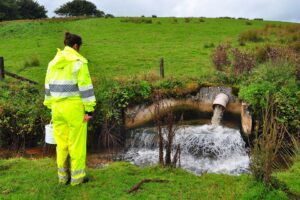In our regular legal column from Eversheds Sutherland, Amy Sadro delves into the Sentencing Guidelines for Health and Safety Offences and questions whether it is consistent for large organisations.
Since the introduction of the Sentencing Guideline for Health and Safety Offences in 2016, we have seen a lack of consistency to the sentencing of Very Large Organisations (VLOs), yet it was consistency that the Guideline was supposed to address.
There have been a number of cases in the Court of Appeal that have sought but failed to address this, so have the Courts simply decided that the large guys must be the bad guys and is that really the case?

Amy Sadro, Principal Associate at Eversheds Sutherland
The Sentencing Guideline for Health and Safety Offences was introduced in 2016 with the aim of bringing consistency to the sentencing of organisations and individuals who are convicted of health and safety offences.
The Guideline sets out a step-by-step approach to sentencing, categorising organisations based on turnover as micro (turnover of not more than £2 million), small (t/o between £2m-10million), medium (t/o between £10m-50million), large (t/o of £50 million and over) or VLOs, which determines a starting point and range for any fine.
The Guideline is explicit as to which organisations fall into which bracket based on turnover, except for VLOs where the Guideline states, “Where an offending organisation’s turnover or equivalent very greatly exceeds the threshold for Large organisations, it may be necessary to move outside the suggested range to achieve a proportionate sentence.”
A number of cases have looked at this question of what is a VLO, and the courts appear to have adopted an approach of “we know one when we see one”, which is not terribly helpful. Our sense is that this will, but not always, be organisations with a turnover of around £250-350 million and upwards.
The fines in health and safety have increased
Since the Guideline has come into force, there is no doubt that the fines in health and safety cases have increased. But has the aim of consistency in approach to sentence been achieved? Having acted for a number of VLOs in both the Crown Courts and Court of Appeal, we would say no.
 There have been a number of cases where VLOs have appealed to the Court of Appeal to reduce the sentence imposed on the basis that a fine was too high given the relevant features of the case; it did not adequately take into account factors like mitigation; it did not properly take into account the nature of the organisation (like being a charity and undertaking a public function); or it was not clear how the court had applied the Guideline steps.
There have been a number of cases where VLOs have appealed to the Court of Appeal to reduce the sentence imposed on the basis that a fine was too high given the relevant features of the case; it did not adequately take into account factors like mitigation; it did not properly take into account the nature of the organisation (like being a charity and undertaking a public function); or it was not clear how the court had applied the Guideline steps.
The Court of Appeal has been reluctant to interfere with any fines and have confirmed that sentencing judges have a wide discretion to deal with VLO’s in the way they see fit; the consistency is around the approach rather than outcome.
What does remain consistent is the desire of sentencing courts to “send the message home” to the senior management and shareholders when imposing sentence, potentially explaining why fines are adjusted upwards and are increasing.
This is not usually something that, at the time of sentencing, is relevant to the VLO clients we represent. Our experience is that VLOs are often the very organisations which commit to and invest significantly in health and safety; “the message’” is clearly embedded at the most senior levels in the business and as a consequence in its history and culture.
Reputation
Furthermore, it is the damage to reputation carefully built up over time caused by a large fine that is usually the concern for VLOs, rather than the monetary penalty, as this can have an impact on future work and relationships with clients. In our experience, these are organisations which invest significantly in health and safety, both in terms of money and time, often sharing how they do things, safety initiatives and programmes with others they work with, contractors, third parties and their supply chain. They are often significant employers in the areas they operate and make investments in local education and generally to the local economy.
VLOs tend to be organisations we expect more from in everything they do including safety management, but given the number of work hours, scale of operations and often level of risk that these organisations are managing on a day-to-day basis, even the best systems are not fool proof.
If a serious incident occurs, it is dealt with at the most senior levels of the organisations and where changes are needed, they are implemented without question and the necessary investment is made. Furthermore, these changes are implemented long before the case comes to court (usually some years after the incident), and so by the time of sentencing, “the message” has been acted upon.
We are often asked by our clients, where do the fines go and do they improve safety? The answer is that they go into treasury funds, not to the prosecuting regulator (the HSE is usually awarded its costs of a successful conviction and have reclaimed investigation fees under the Fee For Intervention regime), nor to any source that would result in an improvement to safety standards anywhere.
To many this simply does not make sense, so should there be another remedy?
The Environment Agency, which investigates and prosecutes environmental offences, uses a civil penalty called an Enforcement Undertaking (EU) as an alternative to prosecution that appears to do just that. Instead of a prosecution for an admitted breach, the duty holder undertakes to invest in defined projects with local partners (usually conservation charities and wildlife trusts), which “protects, restores or enhances the natural capital of England”.

Although EUs are not available for the most serious offences, recent figures published by the Environment Agency show that over the 6 months from June to December 2022, there was nearly £750,000 invested in environmental projects as part of the EU process.
Those numbers may seem low compared to the fines that we see for environmental offences the largest being £90 million and £20 million imposed against VLO water companies, however, it is investment that otherwise would not be there.
A number of our clients whose activities have had a detrimental environmental impact have also committed to voluntary reparation (even where they are being prosecuted). The Courts usually take this investment into account in the sentencing exercise, not as a pound for pound reduction but as demonstrating an organisation that has adopted a responsible response to its offending.
The environmental regime appears to offer more opportunities for VLOs, which are in a position to financially give back to do just that, including beyond their organisations. It will be interesting to see whether the HSE consider adopting a similar approach in the future (having opted not to introduce EUs when the Environment Agency did so), otherwise how can VLOs demonstrate their commitment to health and safety against a regulatory context where we are only going to see fines against VLOs getting bigger.
Amy Sadro is a Principal Associate in Eversheds Sutherland’s Environment, Health and Safety Team. She can be contacted on [email protected]
The Safety Conversation Podcast: Listen now!
The Safety Conversation with SHP (previously the Safety and Health Podcast) aims to bring you the latest news, insights and legislation updates in the form of interviews, discussions and panel debates from leading figures within the profession.
Find us on Apple Podcasts, Spotify and Google Podcasts, subscribe and join the conversation today!


 There have been a number of cases where VLOs have appealed to the Court of Appeal to reduce the sentence imposed on the basis that a fine was too high given the relevant features of the case; it did not adequately take into account factors like mitigation; it did not properly take into account the nature of the organisation (like being a charity and undertaking a public function); or it was not clear how the court had applied the Guideline steps.
There have been a number of cases where VLOs have appealed to the Court of Appeal to reduce the sentence imposed on the basis that a fine was too high given the relevant features of the case; it did not adequately take into account factors like mitigation; it did not properly take into account the nature of the organisation (like being a charity and undertaking a public function); or it was not clear how the court had applied the Guideline steps.

I would be interested to know if the VLO’s invest the same proportion of their turnover into managing safety as say a mid range company does. Or measure it as an investment per person. I would suspect, based on my experience, that the investment is roughly the same or higher in the smaller companies.
I do agreed that fines should go back into supporting improvements in health, safety and wellbeing. Either funding the HSE to investigate more, directed internally to companies on safety improvements, or to support the provision of basic safety training to our young workers.
Hi Trevor, I am not sure of the answer to your question, in any event I suspect the actual spend on H&S may not give a definitive picture, it’s more about the impact and efficacy of what an organisation is doing. On the fines side, I know in environmental matters as well as Enforcement Undertakings, a Water Restoration Fund is now being looked at where fines for pollution offences would be paid into. This would be administered by the Environment Agency and invested in work to enhance biodiversity and the quality of our watercourses. So it seems we are some… Read more »
Definitely a tale from the VLO point of view. Can’t see how the same EU scheme can work in H&S cases. Do they invest in their own H&S, or in the HSE, or in (the largest H&S enforcement body) Local Councils? Would be interesting if the playing field was levelled so that LA enforced premises were treated the same as HSE enforced premises e.g. with FFI. Equally, if fines went to HSE and LA’s they could use that money to invest in their workforce and spend at least some time on proactive preventative work rather than waiting for the serious… Read more »